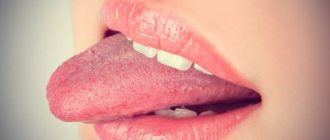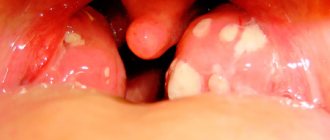White coating on the tongue is a layer of organic substances, bacteria and dead cells, accompanied by swelling of the papillae of the tongue, which can indicate various diseases of the lungs, kidneys or gastrointestinal tract: gastritis, stomach ulcers, enterocolitis.
Plaque on the tongue is a common phenomenon, which many consider simply a feature of their body. And they often forget that you need to brush not only your teeth, but also your tongue. However, many do not know that the appearance of plaque is a symptom usually associated with digestive problems. And it is necessary not only to regularly clean off plaque, but to find the root of the problem and select the appropriate treatment.
If you do not undergo treatment and do not carry out oral care procedures daily, the tongue looks as if it is burned, and bad breath appears. The correct treatment is prescribed by the doctor after testing, and we will try to figure out how to remove plaque from the tongue.
Why do you need to clean your tongue?
When considering the question of how to get rid of white coating on the tongue, you need to start with the basics. The tongue of a healthy person should have a pink color, the surface should be elastic and slightly moisturized. At the same time, a light white coating is not considered a pathology, and this nuisance can be easily eliminated by ordinary cleaning. It's another matter when a strong coating appears. This may indicate the presence of a serious disease in the body.
Cleaning your tongue from plaque at home helps solve the following problems:
- Reduces the concentration of pathogenic bacteria in the oral cavity;
- Prevents the appearance of tartar and caries;
- Freshens breath;
- Improves the functioning of taste buds.
Types of tonsillitis.
The disease occurs in two forms - acute and chronic. Acute tonsillitis is an illness of an infectious nature and manifests itself in acute inflammation of the tonsil. The cause of exacerbation is staphylococci and streptococci. Acute sore throat in children and adults is also divided into catarrhal, follicular, lacunar, ulcerative-membranous and necrotic.
Chronic tonsillitis is a long-term, persistent inflammatory process in the tonsils. It manifests itself as a consequence of past inflammation, acute respiratory viral infections, dental diseases, and reduced immunity. Chronic exacerbation of the disease in adults and children occurs in three forms: compensated, subcompensated and decompensated. In the compensated form, the disease “dormants”; exacerbation of tonsillitis symptoms occurs infrequently. In the case of a subcompensated form of the disease, exacerbations occur frequently, the disease is severe, and complications are common. The decompensated form is characterized by a long, sluggish course.
Reasons for appearance
Why does white plaque appear? The main reason lies in food debris that gets stuck between the lingual papillae. As a result, a favorable environment is created for the proliferation of bacteria. Most of these microorganisms die, but do not disappear without a trace. When in contact with saliva and epithelial particles, they stick to the tongue, forming a plaque. In this case, this plaque is partially removed by salivation. The film usually remains in hard-to-reach places, for example, at the root of the tongue. If it is not cleaned in time, it begins to spread to other areas, gradually covering the entire tongue. Considering that these are the remains of bacteria, the likelihood of developing dental diseases increases sharply.
Complex therapy of chronic tonsillitis at the ENT Clinic of Doctor Zaitsev.
The method of complex treatment of the disease did not appear immediately. Our specialists have tried various methods of treating tonsillitis in practice. As a result of many years of experience in the study and treatment of chronic tonsillitis, this technique has taken root and is the most effective. It includes several stages.
The first stage is anesthesia of the tonsils. The tonsil is lubricated with lidocaine. The second stage is vacuum washing of the tonsils from caseous masses. The third stage is medicinal treatment of the tonsils using ultrasound. The fourth stage is irrigation of the tonsils with an antiseptic.
Stage five - lubricating the surface of the tonsils with Lugol's antiseptic solution. The sixth stage is physical therapy using a laser - this procedure relieves swelling and inflammation of the tonsils. The next stage is a vibroacoustic effect on the tonsils, due to which the blood flow rushes directly to the tonsils, and pathogenic substances are removed with it. The final stage of complex treatment is a session of ultraviolet irradiation, which heals the tonsils and fights pathogens.
The entire session takes about twenty minutes. To achieve a positive result, the patient usually needs five complex procedures.
Signs of plaque on the tongue
Tongue plaque can be a physiological phenomenon or a side symptom of a serious disease. In the first case, you can remove the white coating on the tongue yourself, without going to the dentist. In the second, you will need the help of a qualified specialist. A white tongue can directly indicate a fungal infection or dehydration of the body
Physiological signs:
- Uniform white or yellowish color;
- A thin layer through which the lingual papillae are clearly visible;
- No unpleasant odor, pain, or other symptoms;
- Appears for certain reasons, for example, due to thirst;
- Easy to clean with a toothbrush.
Pathological signs:
- Dense consistency, difficult to remove;
- Unhealthy color: yellow, brown, gray;
- Covers the entire surface of the tongue;
- Accompanied by an unpleasant odor;
- A sour or bitter taste appears in the mouth.
Determining the disease by the color of plaque
The first diagnostician on the condition of the tongue was the Russian doctor M. A. Nechaev, who in 1833 published the book “Recognition of diseases by changes in the language” in the printing house of Kazan University. Several generations of Russian doctors were grateful to him for this unique work, which helped to carry out diagnostics without additional instruments.
Today, the technique is widely used not only among traditional healers, but also among practitioners of traditional medicine. However, the diagnosis must be confirmed after a comprehensive examination carried out in a laboratory, or using ultrasound, CT, MRI, fluoroscopy, etc.
What do you pay attention to during this diagnosis:
- plaque color;
- its consistency.
As for the color of plaque, it can be:
- white;
- grey;
- yellow;
- greenish;
- bluish;
- brown;
- even black.
And the consistency can be:
- almost transparent;
- flaky;
- viscous.
All signs are compared, and a certain diagnostic verdict is made.
How to remove plaque from the tongue at home
How and with what to clean the tongue of an adult? There are several ways to quickly deal with this problem. Let's look at each of them in more detail.
Scrapers
These are special loop-shaped devices made of hygienic plastic. Scrapers effectively remove plaque without causing discomfort or gag reflexes. The tool must be moved from the base of the tongue to the tip until the film disappears. After this, the mouth can be rinsed with an antibacterial solution.
Toothbrushes
Most models have special pads on the back surface or removable attachments for removing plaque. Hygienic procedures are carried out according to the scheme discussed above. To enhance the effect, you can apply a small amount of toothpaste to the surface of the nozzle.
Irrigators
These are modern devices for comprehensive oral care. The essence of the irrigator’s work is the directed supply of a stream of water, which gently but effectively removes food debris and plaque on tooth enamel and tongue. Irrigators work very delicately, the possibility of damage to the mucous membrane is completely eliminated. In this case, to enhance the effect, water can be replaced with a medicinal liquid with an antibacterial or anti-inflammatory effect.
Spoons
Sold in pharmacies, in appearance they resemble a small spatula with rounded edges. Thanks to this form, the possibility of injuring the tongue is eliminated.
Special spoon attachments are available for irrigators. For example, a replaceable nozzle TS-100E. This instrument is recommended by dentists for daily hygiene procedures; it effectively removes plaque and helps freshen breath.
Rinse
To clean the tongue, decoctions based on medicinal herbs and plants are used:
- Oak bark;
- Propolis;
- Calendula;
- Sage.
However, it is important to understand that it will not be possible to remove plaque with the help of decoctions alone. This method cannot replace mechanical cleaning and is used rather for preventive purposes.
Cleaning accessories
If you mainly use a brush for dental hygiene, there is a whole cleaning kit for your tongue.
Brush
You can remove plaque buildup with a standard toothbrush. If you are afraid of discomfort, you should choose a device with ultra-soft bristles. Modern dentistry recommends using a special brush for cleaning the tongue with a ribbed surface on the back side. This device makes the procedure painless and safe.
Scraper
A tongue scraper is very convenient because it can cover a larger surface area at once than other tools. This avoids the risk of a gag reflex. It is usually made of plastic in the form of a spoon on a handle.
After the procedure, the scraper must be washed thoroughly. Like other devices, it needs to be changed from time to time.
Spoon
A tongue cleaning spoon is an excellent tool for removing thick plaque and bad breath. The shape of the spoon is an elastic handle with a tip. Use this device after brushing your teeth.
Whatever device you use, it should be individual for each family member.
How to properly clean your tongue with a toothbrush
How to properly clean plaque from your tongue using a toothbrush? To do this, it is enough to follow the following rules:
- Cleaning is performed after basic hygiene procedures: brushing the teeth and rinsing the mouth;
- Plaque is removed with progressive movements: the brush goes in one direction, first from the root to the tip of the tongue;
- Then the brush moves in the transverse direction, and then in the return direction: from tip to root;
- 4-6 movements are made in each direction;
- After this, the inner surface of the cheeks is carefully processed,
- At the final stage, rinse with an antibacterial solution.
Pregnancy and chronic tonsillitis.
The health of the expectant mother and baby requires close attention. Complications caused by the disease can lead to dangerous consequences, including miscarriage or provoke premature birth. Self-medication in this case is dangerous: it is necessary to undergo treatment with an ENT specialist in the clinic. The doctor will prescribe washing the tonsils, treating them with ultrasound and gargling with antiseptics that are safe for the expectant mother. Physiotherapy is contraindicated for pregnant women.
If you are just planning a pregnancy, it is worth carrying out planned therapy for prevention in order to reduce the negative impact of pathogens on the tonsils. At the planning stage of pregnancy, it is recommended that both parents undergo an examination to reduce the risk of this disease in the child.
Friends! Timely and correct treatment will ensure you a speedy recovery!
How to properly clean your tongue with an irrigator
Cleaning the tongue from plaque with an irrigator is carried out in compliance with the following rules:
- The procedure begins with a slight pressure, which gradually intensifies;
- The angle of impact of the jet should vary between 60-90 degrees;
- Duration of cleaning – 2-3 minutes;
- First, the general surface of the tongue is processed, then hard-to-reach areas;
- The procedure must be performed daily, at least once.
It is important to understand that the use of irrigators does not mean giving up mechanical brushing of teeth. Therapeutic liquids for the device are used strictly as prescribed by the doctor.
Why does there be an unpleasant odor?
The oral cavity is the beginning of the digestive tract. It contains many bacteria; saliva contains enzymes that can break down carbohydrates. Therefore, after waking up, all people have bad breath. But this condition is not considered a pathology; it is enough to brush your teeth for the smell to disappear.
A persistent unpleasant aroma appears after eating dishes with garlic, onions, and some spices. When alcohol is abused, the sour stench persists for a day or more, which is associated with the metabolism of ethyl alcohol in the liver and the release of its vapors through the lungs.
A large number of unpleasant aromas accompany diseases that affect metabolism. In patients with diabetes who do not follow a diet or use insulin incorrectly, when ketone bodies accumulate in the blood, the smell of acetone appears on their breath. People suffering from kidney failure will repel those around them with the unpleasant aroma of urea, which the kidneys cannot remove from the body.
Common causes in adults are pathologies of the digestive tract. Halitosis is caused by:
- gastritis with high acidity;
- stomach ulcer, duodenal ulcer;
- cardiac sphincter insufficiency;
- esophageal diverticula;
- malignant tumors of the stomach or esophagus.
Respiratory diseases can also cause an unpleasant odor. Air from the lungs passes through the oropharynx, so it can partially leave the body through the mouth. It smells unpleasant with purulent diseases of the sinuses, chronic runny nose or tonsillitis.
Prevention of plaque formation on the tongue
- Brush your teeth and tongue at least twice a day;
- Include fermented milk products in your daily diet, eat more vegetables and fruits;
- Reduce the amount of spices, spicy and smoked foods you consume;
- Quit smoking and alcoholic beverages;
- Regularly undergo preventive examinations at the dentist;
- Do not cause diseases of the gastrointestinal tract.
Do I need to clean my tongue of plaque? Of course, even if we are talking about the physiological characteristics of the body. The film that appears on the tongue is traces of the vital activity of pathogenic bacteria, so if the plaque is left unattended, a favorable environment is created for the development of infectious diseases of the oral cavity.
Thanks to irrigators and other devices, taking care of your oral cavity is not at all difficult, and by spending just a few minutes a day, you can maintain a snow-white smile for many years.
Author of the article
Treatment
For your information! In certain cases, treatment may differ radically (based on the root cause of the appearance of white plaque).
So, depending on the underlying pathology, the patient is prescribed the following treatment:
- In case of problems with the gastrointestinal tract the diet is , excluding all harmful foods from the diet. First of all, fatty meat, fried foods, fast food. This also includes sour cream, butter, alcohol and sweet carbonated drinks. Prescribe medications appropriate to the current disease. The treatment is carried out by a gastroenterologist.
- For influenza and ARVI, antipyretics (Paracetamol, Ibuprofen, etc.) and drugs for topical use are prescribed Among them, nasal drops - Naphthyzin, Xylometazoline, Otrivin, etc.; tablets and lozenges for resorption with anti-inflammatory action - Doctor Mom, Strepsils, etc.
- In case of fungal infection of the oral cavity , the patient is prescribed antifungal drugs. Among them: Rumicosis, Fungicidin, Diflucan, Nystatin, etc.
- If you have a sore throat and other throat diseases , drugs such as Faringosept, Ingalipt, Neo-angin, Septolete , etc. are recommended. Antiseptics (Miramistin and Chlorhexidine), Furacilin solution (1 tablet per glass of warm water) are prescribed as rinses. You can use a soda-salt solution (1 teaspoon of each per glass of warm water). Decoctions of chamomile, sage, and calendula are also suitable (1 tablespoon of raw material per glass of boiling water).
- For bacterial infections , oral antibiotics are indicated (Sumamed, Amoxiclav, Cephalexin, Azitrox, etc.). In this case, it is necessary to complete the full course of treatment. Even if the symptoms go away a few days after starting therapy.
- For glossitis , first of all, it is necessary to exclude hot and spicy foods from the diet. Remove from the diet too salty, with the addition of red or black pepper, garlic, onion, mustard, various sauces, etc. And it is important to rinse your mouth with Chlorhexidine, Miramistin, a weak solution of potassium permanganate, Furacilin, herbal infusions, etc. .
- In case of hormonal disorders , treatment is carried out by an endocrinologist. The course of treatment and dosage of certain medications is prescribed by the doctor. Self-medication is unacceptable, because without knowing the true cause of plaque, therapy will be meaningless and can only worsen the situation.











